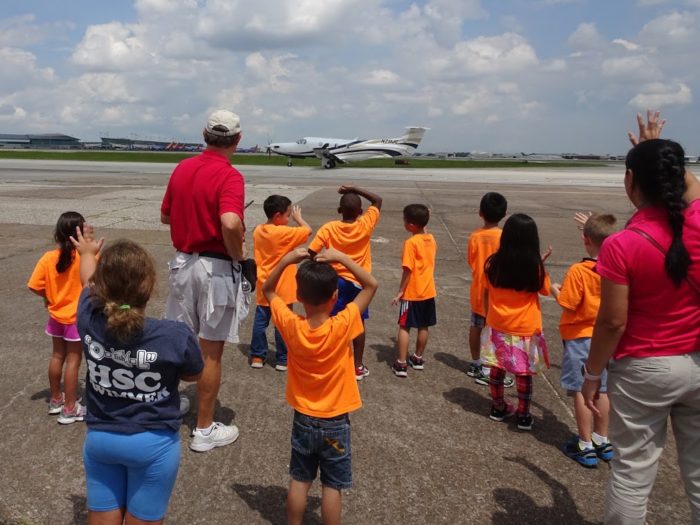Welcome to our community spotlight series where we bring the Hobby Area District community even closer together by getting to know some of our outstanding community leaders.
Have you ever wondered how the Hobby Area District logo originated? It was inspired by the 1940 Air Terminal Museum. On the Hobby Airport premises, you can get a closeup view of the impact of aviation on Houston’s history and economic development through the prism of architectural beauty.
We talked about the 1940 Air Terminal Museum with Executive Director Amy Rogers.
What can I expect if I come to visit the 1940 Air Terminal Museum?
First of all, a visitor to the museum is usually blown away by the beautiful architecture of the original terminal building. It is an art deco style building and construction was completed in September 1940. If you are good at math, that means it is coming up on its 80th birthday this September. For Houston, that’s a really big deal. As we know, Houston is such a thriving, growing city that is constantly building new businesses and new places to live. Unfortunately, a lot of the older buildings are torn down to make way for that because we know first-hand that taking care of older buildings is extremely expensive. We do not fault the city, but we hope that it can hold on to a little more of its history. Luckily we still have the original airport.
The terminal was designed by a famous local architect named Joseph Finger, who is most famously known for Houston City Hall. A lot of people immediately connect the styles between this building and City Hall, and they start to notice some of the similarities of the architecture that he put into these properties. Another thing is that they get to enter the building through the same exact doors that you would have entered through if you were using this airport in the ’40s and ’50s. They’re taken back in time and step into the exact space and onto the marble floors travelers used back then.

Interior of the Terminal – photo credited to Blair McFarlain
When you look around the grand atrium space, you’ll see a lot of the original wainscoting around the pillars along the walls. You’ll see so many original aspects of the building, including the grand chandelier in the center of the room. You will see some reproductions of light fixtures and things like that, but they were created based on historic photographs. They’re as close to it as we could possibly get. You’ll also be able to enter the North Wing galleries and the South Wing galleries which feature several displays of aviation and airline memorabilia, including things like pilot uniforms and, as they were called during that time, stewardess uniforms. We now refer to them as flight attendants.

Pilot and stewardess uniforms – photo credit to George Haines
You’ll see several historic photographs that show you people who worked for the airline industry and people who flew on airplanes during that time. We have a collection of fine china that was used to serve first-class passengers. There are lots of artifacts for people to see. Also, a part of the museum campus is our 1928 airmail hangar, which is the oldest structure on the entire airport. It houses our collection of vintage aircraft and flight simulators. It serves as archival storage and offices as well.

Vintage Pioneer DC-3 at the Terminal – photo credited to the 1940 Air Terminal Museum
All of our aircraft are static display only. We are not in the business of flying aircraft. It’s an extremely expensive thing to do. As a museum, we focus our resources more on the historic structure itself rather than flying the airplanes, but all of the airplanes we have are historic in their own right. We have a 1942 Lockheed Lodestar, which would have been an example of an airplane used back in the ’40s and ’50s for business people to travel to their oil fields and check on their businesses outside of Houston. We also have a 1943 Cessna Bobcat and a 1958 Sikorsky helicopter. The museum has some models of smaller airplanes and engines that allow students to get a really up close and detailed look at how an airplane engine looks for several different types.

A 1943 Cessna Bobcat – photo credited to George Haines
Everything that you see within the museum, the exhibits, the memorabilia, the artifacts, and the airplanes have come to us as from people who used to work in the industry or their families. Even private collectors that start to do away with some of those things in their house come and bring them to the museum. These items allow us to tell everyone the story of Houston aviation history.
If I wanted to come to visit, how would I get there?
The museum is accessible from any direction. We like to direct people to come in via I-45 and travel down Broadway Street because we love to show off the work that the Hobby Area Management District has done along the street with the revitalization of that area. Our favorite part of that is showing off the mini mural art projects that feature so much of the museum history through the artist designs.
When I visit, will I see flying planes?
Yes, of course. I mentioned before that we don’t fly any of the aircraft that we own in our collection, but don’t be upset because you will certainly see lots of flying airplanes. The most exciting thing about the museum is that we are located on the modern-day Hobby Airport on the west side of the airport off Telephone Road. We have one of the best viewpoints of the active runways of anywhere on the airport. It really can’t be beat. You have a front-row seat to the active runways and can see all of the commercial airplanes like Southwest and Delta, business airplanes, and private jets taking off and landing all day long from the museum.
If you visit the museum, you’ll be able to see a lot of the airline history. You mentioned that you get those items donated. Can anybody donate to the museum?
Yes, absolutely. Anyone who wants to donate an item to the museum is most welcome to do so. We do have a donation agreement that just goes over how to donate. When you donate something, it doesn’t necessarily mean that the museum will be able to put it out on display right away, but that we will certainly take great care of it. It will be located in a protected archival area until we have a special exhibit space to showcase it in.
We also ask that anyone who’s considering donating something to the museum to make sure that it’s something that would fit within our collection. We can’t accept an item that we know we could never display.
For example, we get some people who want to donate the beautiful military aviation history from one of their family members. We suggest that they talk to a museum like Lone Star Flight Museum or one of the others that focuses on military aviation history. The story that we’re telling is of this building, and this building served commercial aviation traffic. We would never want to accept their beautiful items and never be able to tell their story within our space. We always do our best to suggest somewhere else they can donate their great items.
What are some can’t-miss things at the museum?
My favorite “can’t miss” at the museum is quite literally a can’t miss when you pull in. You’re greeted by a beautiful 1969 Hawker jet that has been painted by famous Houston graffiti artist Gonzo247. This airplane is painted in Gonzo’s famous, bright, beautiful, eclectic style, and he incorporated different components of aviation history and history of the Hobby area. They’re hidden within the design like little Easter eggs. We love watching people try to find the different items and then asking us questions like, “I think I found this” and “What does this mean?” For example, on the tail of the airplane there are these beautiful peacock feathers. That’s a nod to the wild peacocks that are throughout Garden Villas neighborhood, just right up the street from the museum. There are little things like that hidden throughout that we love people to look for. To us, it makes this piece of public art more than just a piece that the museum commissioned with Gonzo. It makes it more of a community-focused piece.

The featured 1969 Hawker airplane painted by famous Houston graffiti artist, Gonzo247 – photo credited to George Haines
Can you tell me a fact about the museum that most don’t know?
A lot of people don’t realize that the 1940 Air Terminal Museum is the only original airport terminal building left in this country that’s currently being used as a museum and that it still sits on an active commercial airport. It gives you the big picture of walking into part of aviation history while also looking out over the current way things are with aviation. It’s a truly unique and incredible experience that we can give to our visitors because of the cooperation we have with the airport and its support of the museum being here. They’re supportive of it being preserved and utilized as a museum. We’re just so fortunate to be able to give people that type of experience.

Photo credited to George Haines
Something we hear a lot, especially from younger children who have grown up in this post 9/11 world, is that they don’t know the airport as anything other than a place with lots of security, gates, fences, and places you’re not allowed to go. We all know that we need those security measures in place and we’re also thankful for them, but when we are able to open the gate to an active airport and walk them out and allow them to be standing only feet away from active taxiways and watching the airplanes up close and personal, they get so super-excited. They almost seem a little frightened at first like, “I’m not supposed to be out here. I don’t know that this is allowed.” It’s just really incredible to talk to them about the history of this incredible and beautiful building and also show them current day aviation.
I’ve seen people attend events at the museum. Can you rent it out?
Yes, the museum can be rented for weddings, birthday parties, quinceañeras, and corporate events as well. The events can be from 50 people or up to 200 people. The museum has several spaces that can be used for a private event. We have a small meeting room that can host up to 50 people. We also have our larger space which is the grand atrium, which is pretty much the entire first floor. It can be rented out for up to 200 people. For larger events we have our hangar. The hangar is like an indoor/outdoor space. It’s really perfect for festivals, outdoor events, or car shows, especially during the summer.
Some of the great things that people really enjoy is that they’re able to bring in their own caterers and decor. We offer the space for them and they’re able to make their vision happen. We try to work with everybody. Those are some big selling points for us, especially with people who are doing a lot of DIY weddings; it’s flexible. They can really do whatever they want in terms of who they want to work with to bring them here for their wedding or for their special event.
The museum and hangar space can also be utilized for other creative ventures. Photographers may want to do a styled shoot or there may be somebody who wants to shoot a short film or do something fun like that. We are open to any ideas and love to collaborate with anyone who may want to come out here and support us. We book a lot of couples photo shoots due to the very romantic and historical vibe the building has to offer. They love a 1940’s art deco theme! I’ve seen a lot of modern photo shoots too, and so it’s a good contrast of both worlds.
It’s great to have people come in and utilize the space and to see them create their own memories to cherish for years to come. In addition to the museum we also offer the vintage planes that make for some larger than life photos!
One of the great things about having events here with us is that it helps support the museum. The funds that are raised through event rentals, photo shoots, or video shoots all go right back into operating the museum and further preservation of the terminal.
If I want to rent it out, how would I do that?
One way is to contact Juan at [email protected] or call the museum at 713-454-1940. Another way to connect with us is on our website or via social media @1940ATM. On our website we have an inquiry form to fill out with some basic information about your group size, what you’re celebrating, and your desired event date.
I heard that Humphrey Bogart once visited the terminal. Is that true?
Yes, that would be true. You can actually see a photograph of him in one of our exhibit cases right in the Grand Atrium space. What’s really neat about looking at the photo is that where you stand to look at it, if you look straight out in front of you you’re looking at exactly where he would have been sitting in that photo!
How do I become a volunteer?
You can call the museum or go on to our website, www.1940airterminal.org, and there’s a tab called Get Involved. They can fill out a very short volunteer application. Our volunteer coordinator, whose name is George Haines, will reach out to them, schedule a time to meet, give them a walk-through, and fill them in on everything they would need to know to be a volunteer. Some organizations require someone to give a certain amount of time, but we do not have any strict requirements like that. We will take a volunteer who maybe only has two hours a month to give, or we will take volunteers who have eight hours a week to give. We are appreciative of any help that we can get.
Special thanks to Juan Ortiz, Events Manager at the 1940 Air Terminal Museum for answering our events questions.
The museum is open Tuesdays through Sundays. Tickets are $5.00 for adults and $2.00 for children, the same price since the museum opened. Museum members, U.S. military, police and firefighters receive free admission.




